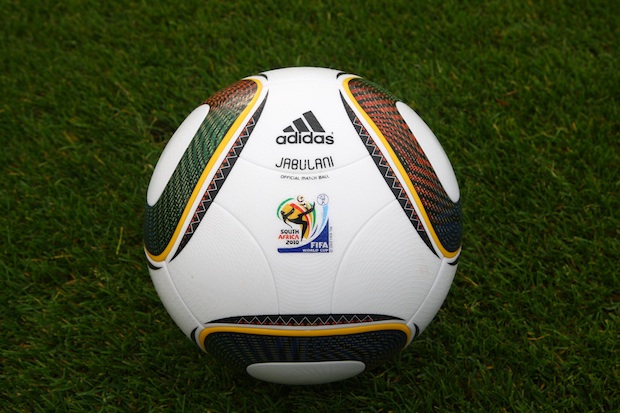
Happening right now (well, when this first appears on the front page) is the draw for the 2010 FIFA World Cup. It’s a big deal, and will lead to endless debate on call-in radio shows all over the world: what’s the real group of death? Does [our country] have a chance? Can anyone beat Brazil or Spain? And so on. But the World Cup is pretty useless without, you know, the ball. So, presenting the adidas Jabulani, the ball that will be used during the tournament. There’s a lot going on in that ball, believe me.
I spoke to a few people at adidas earlier this week, and they gave me a bit of a rundown on the technology of the ball, technology that should ensure that the Jabulani is the most accurate ball ever used.
But first, the name: Jabulani? As you know, the World Cup will be held in South Africa, and Jabulani is a Zulu (one of the 11 official languages there) word meaning “to celebrate.” Makes sense: the World Cup is right up there with the Olympics in terms of world coming together-ness. (I’d argue that the World Cup is far more important to the average guy than the Olympics. Really, how many people pay close attention to all the obscure sports at an Olympics? Whereas the World Cup commands the everyman’s undivided attention.)
Moving on, why should you, the CrunchGear readers, care about a ball? I don’t know, because it’s pretty damn advanced? I mean, it’s only been in development from the day after the 2006 World Cup ended!
Adidas has managed to increase the ball’s striking surface by as much as 70 percent by reducing the number of 3D panels from 14 (from the 2006 World Cup) to eight. Less panels reduces the number of seams on the ball, and, coupled with another adidas-developed technology called Grip’n’Groove, should also increase the power behind the ball.
More power = more goals. That’s what we want to see.
Grip’n’Groove also gives the ball a slight “dimpled” surface, called Aero Grooves, which should help improve the ball’s accuracy.
You can almost picutre Spain’s Xavi picking his corner during a free-kick, then flighting the ball over the hapless wall.
I asked adidas how they go about developing these balls, and it turns out that there’s a lot of player input. Chelsea and Czech Republic goalkeeper Peter Cech, Chelsea and Germany’s Michael Ballack, Chelsea and England’s Frank Lampard, and Real Madrid and Brazil’s Kaká all gave adidas their opinions on the ball as it was being developed. Adidas also worked with AC Milan, Bayern Munich, the Orlando Pirates (man, who ever thought you’d see AC Milan and the Orlando Pirates in the same sentence?), and Ajax Cape Town for further input.
In other words, it’s not just adidas’ engineers sitting in front of a computer screen all day developing the ball.
Needless to say, adidas put a lot of work into this ball to make sure that it’s the best one ever seen. (Incidentally, the Jabulani doesn’t share too much in common with the ball used at last year’s European Championships, the Europass.) Here’s hoping Team USA can lift the trophy. Failing that, I’ll settle for a Spain victory.